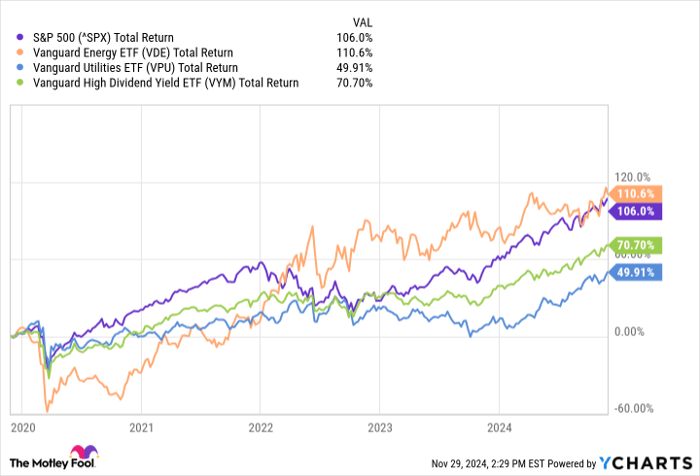Investment management company Vanguard offers more than 60 equity-focused exchange-traded funds (ETFs) that focus on various investment styles and themes -- all while charging expense ratios as low as 0.03% to as high as 0.22%.
While plenty of dividend-focused Vanguard funds are great for generating passive income, not all of them have produced impressive gains this year. Here's a closer look at three high-yield Vanguard ETFs that can continue rewarding patient investors.

Image source: Getty Images.
Two sector ETFs with high yields
Vanguard offers ETFs that track the performance of all 11 Global Industry Classification Standard stock market sectors. Among the highest-yielding sector ETFs are the Vanguard Energy ETF (NYSEMKT: VDE) and the Vanguard Utilities ETF (NYSEMKT: VPU), which yield 3.3% and 2.9%, respectively.
Both funds are similar because they feature identical expense ratios of 0.1% -- or $10 for every $1,000 invested. They are also both relatively top-heavy.
Around 50% of the Vanguard Energy ETF is concentrated in just five stocks: integrated majors ExxonMobil and Chevron, exploration and production companies ConocoPhillips and EOG Resources, and pipeline giant Williams.
Meanwhile, 36.5% of the Vanguard Utilities ETF is in its top holdings -- and around 63% of the fund is in electric utilities.
Given the cyclicality of the oil and gas industry, it can be better to be heavily concentrated in some of the more stable companies instead of investing in highly volatile or less financially healthy companies. For example, ExxonMobil and Chevron have increased their dividends for 42 and 37 consecutive years, respectively. They also have solid balance sheets with low debt-to-equity ratios -- which is impressive given the capital-intensive nature of the oil and gas industry.
An ETF can also be useful in the utility sector because many utilities specialize in a certain region. For example, the largest holding in the Vanguard Utilities ETF -- NextEra Energy -- has a subsidiary called Florida Power & Light, which is the largest electric utility in the U.S. The second-largest holding in the ETF, Southern Company, primarily focuses on the Southeastern U.S. Investing in an ETF helps smooth out some of the geographic risks, such as natural disasters or population changes that can impact electricity demand.
In sum, the Vanguard Energy ETF and Vanguard Utilities ETF offer excellent starting points for investing in either sector. Still, the Vanguard High Dividend Yield ETF (NYSEMKT: VYM) may be an even better buy now.
Data by YCharts.
A unique Vanguard ETF that blends value, income, and growth
The Vanguard High Dividend Yield ETF has a yield of 2.8%, so it offers similar passive income as the Vanguard Energy ETF or Utilities ETF but with a slightly lower expense ratio of 0.06%.
Targeting top stocks from a variety of sectors, the ETF is far more diversified than a sector ETF. It is also less top-heavy, with just 15.4% invested in its top five holdings -- Broadcom, JPMorgan Chase, ExxonMobil, Home Depot, and Procter & Gamble.
If you scan the holdings of the Vanguard High Dividend Yield ETF, you'll find many recognizable blue chip dividend stocks. However, investing in some of these stocks wouldn't generate a sizable enough yield for passive income investors. For example, Walmart is a top 10 holding in the fund, but the stock now yields just 1% after its massive 72% year-to-date run-up. Similarly, the top holding, Broadcom, only yields 1.3%. Broadcom has boosted its dividend by 63% in just five years -- which is excellent, but the stock is up a whopping 400%, which has pushed the yield down.
The Vanguard High Dividend Yield ETF effectively offsets the low yields of some strong-performing companies with stodgier, high-yield companies. For example, Johnson & Johnson makes up around the same weighting in the fund as Walmart, but J&J has a yield of 3.2% and a lower valuation than Walmart. By investing in both companies, investors get the best of both worlds -- a company at the top of its game in Walmart and the passive income of J&J.
It's also worth mentioning that the Vanguard High Dividend Yield ETF has a higher yield than other well-known Vanguard value-focused funds, like the Vanguard Value ETF or the Vanguard Mega Cap Value ETF, which both yield 2.3% -- or the Vanguard Dividend Appreciation ETF, which yields just 1.8%.
A historically effective way to compound your money
Investors looking to generate passive income from a diversified portfolio of companies may want to take a closer look at the Vanguard High Dividend Yield ETF. The fund offers an excellent balance of value and income while ensuring the investment thesis isn't just centered on passive income alone.
In addition to being up around 20% year to date, the fund is up 46.4% over the last five years and 91.1% over the last decade -- and that's without factoring in dividends. Once dividends are accounted for, the fund's total return over the last decade is 162%, illustrating how the fund rewards investors with passive income and potential capital gains.
All told, the Vanguard High Dividend Yield ETF offers risk-averse investors a way to put capital to work even with the broader indexes around all-time highs.
Should you invest $1,000 in Vanguard Whitehall Funds - Vanguard High Dividend Yield ETF right now?
Before you buy stock in Vanguard Whitehall Funds - Vanguard High Dividend Yield ETF, consider this:
The Motley Fool Stock Advisor analyst team just identified what they believe are the 10 best stocks for investors to buy now… and Vanguard Whitehall Funds - Vanguard High Dividend Yield ETF wasn’t one of them. The 10 stocks that made the cut could produce monster returns in the coming years.
Consider when Nvidia made this list on April 15, 2005... if you invested $1,000 at the time of our recommendation, you’d have $847,211!*
Stock Advisor provides investors with an easy-to-follow blueprint for success, including guidance on building a portfolio, regular updates from analysts, and two new stock picks each month. The Stock Advisor service has more than quadrupled the return of S&P 500 since 2002*.
*Stock Advisor returns as of November 25, 2024
JPMorgan Chase is an advertising partner of Motley Fool Money. Daniel Foelber has no position in any of the stocks mentioned. The Motley Fool has positions in and recommends Chevron, EOG Resources, Home Depot, JPMorgan Chase, NextEra Energy, Vanguard Dividend Appreciation ETF, Vanguard Index Funds - Vanguard Value ETF, Vanguard Whitehall Funds - Vanguard High Dividend Yield ETF, and Walmart. The Motley Fool recommends Broadcom and Johnson & Johnson. The Motley Fool has a disclosure policy.
The views and opinions expressed herein are the views and opinions of the author and do not necessarily reflect those of Nasdaq, Inc.



